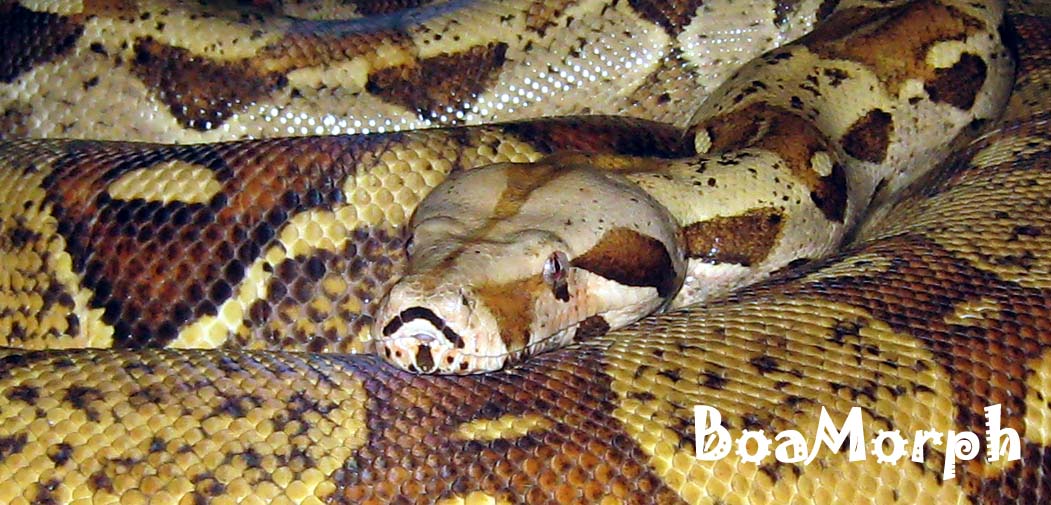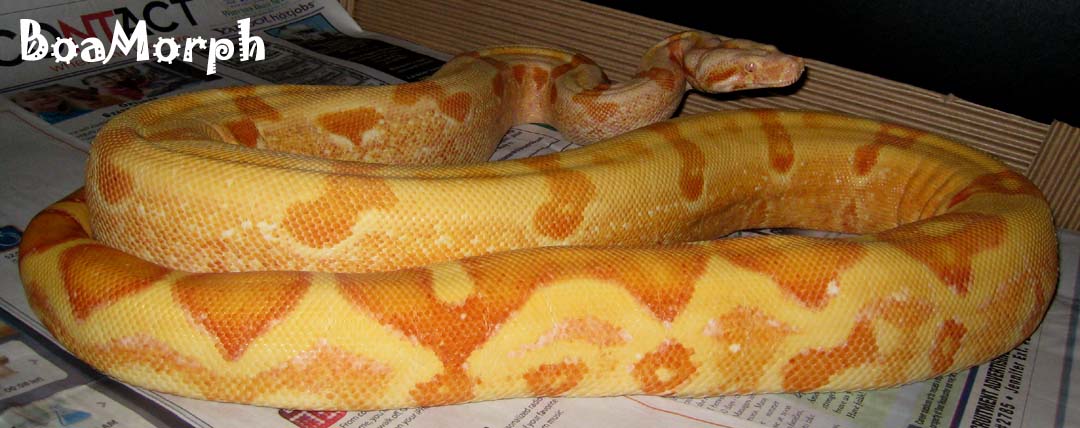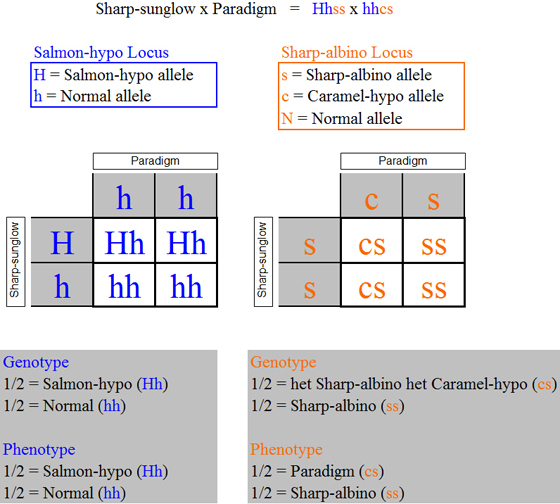|
So what do I get when I cross my Paradigm boa to my Sharp-sunglow boa? Such multi‑trait crosses are where the genetics start to get REALLY fun, and
have kept me up late many nights puzzling out the offspring genotype/phenotype ratios from all kinds of crazy hypothetical
crosses. For now we will start with the relatively simple example posed above.

|
| Paradigm Boa |

|
| Sharp Sunglow |
Such crosses involving multiple independent traits can be evaluated using a
Punnett square (4x4 for two traits, 6x6 for three traits, etc.), but it gets very tricky to correctly distribute the alleles
in the parents’ boxes of the square as the square gets larger and it is easy to make mistakes. It is actually simpler to use a statistical approach, and the good news is that you don’t need to
know anything about statistics to use it!
In considering our Paradigm to Sharp-sunglow test cross we are dealing with
two loci, one being the Sharp-albino locus, and the other which we will call the Salmon-hypo locus. The combinations of alleles at the Sharp-albino locus and at the Salmon-hypo locus are unaffected by each
other (note specifically that the Salmon-hypo trait is completely separate and independent from the Caramel-hypo trait), and
so we can analyze the allele combinations at these loci independently using the familiar 2x2 Punnett square as shown below.

The Salmon-hypo trait is co-dominant leaning toward complete dominance (remember
our previous discussion about the “spectrum of dominance”). Although
there appear to be tendencies in certain visual features that may in some cases allow a trained eye to distinguish homozygous
Salmon-hypos (or “SuperSalmon-hypos”; HH) from heterozygous Salmon-hypos (simply called “Salmon-hypos”;
Hh), the indicators that have been identified so far have proven to be less than 100 percent reliable. The questionable visual distinctions between Salmon-hypos and SuperSalmon-hypos will not matter in this
example, but the information has been provided for completeness regarding the nature of this trait.
In order to determine how the Salmon-hypo and Sharp-albino loci traits will
combine in the offspring, we must merge the above results for these two loci using a simple statistical method. The four arrows in the diagram below indicate the four possible combinations of results at these two loci.

The expected frequency of each of the four possible outcomes is obtained by
simply multiplying the frequencies from the two loci together for each possible combination as shown below.

This process can be further simplified by creating a well-organized table as
shown below. The possible outcomes for the Salmon-hypo locus are shown in the
leftmost column. In the second column, the possible outcomes for the Sharp-albino
locus are repeated for each possible outcome in the previous column. We then
simply multiply all of the boxes across from left to right to obtain our four possible outcomes and associated frequencies.

|
| Click on the image to view full size. |
Note that this is a relatively simple example in that there are only two possible
outcomes at each of the two loci. Additionally, each of the genotypes of both
the parents and the offspring has a unique phenotype, and so we did not need to consider the significance of whether we multiplied
genotype frequencies or phenotype frequencies because they are the same in this example.
Later we will consider some more complicated examples in which the genotype and phenotype frequencies differ, and for
which there are more than two loci involved in the test cross.
So where’s the fun? Personally,
I have had a BLAST playing around with every conceivable combination of the Paradigm with other traits! Motley Paraglow, anyone? How about a Paraghost, and will it
be distinguishable from a ghost? The possibilities are mind-boggling! Playing with the genetics isn’t your thing? Then consider
that beyond the genetics, the REALLY exciting thing about the Paradigms is that you can produce completely new visual morphs
with first generation crosses to morphs that exist NOW!
Consider the example above – by crossing a Sharp-sunglow with a Paradigm
we can produce a litter in which one fourth (on average) of the offspring will be Paraglows, a visual morph that did
not previously exist (until Mike Weitzman produced it at Basically Boas in the summer of 2007, that is….please visit
www.BasicallyBoas.com to view some photos of this AWESOME boa!). Sure beats the heck out of breeding
a het albino motley to a double het sunglow hoping for the 1 in 16 sunglow motley!!!
That’s not to say that producing sunglow motleys isn’t a worthy endeavor – we’re actually
hoping for some good luck with that ourselves! But the comparison shows
the enormous potential with the Paradigms to produce new visual morphs without having to wait for heterozygotes to mature
and breed to finally see something new!
So, is the Paradigm a shooting star, destined to quickly plummet in value mired
in its own vast numbers? Not at all! Consider
that as the test crosses become ever more complex and involve greater numbers
of loci and alleles, the probabilities of producing those next new morph combinations become much smaller. Additionally, outcrossing is critical to help ensure the continued production of quality litters of healthy,
robust baby boas, and further regulates the numbers of new Paradigm morph boas that can be produced. There is excellent potential both short-term and long-term with the Paradigm project!
Some of the more complicated test crosses that are expected to result in new
Paradigm morph combinations in the next few years are evaluated in the following pages.
Continue to "5. Paradigm x Salmon-hypo het Sharp-albino"
Back to "3. The ParaHet"
Back to the "Genetics and Paradigms" Page
|

